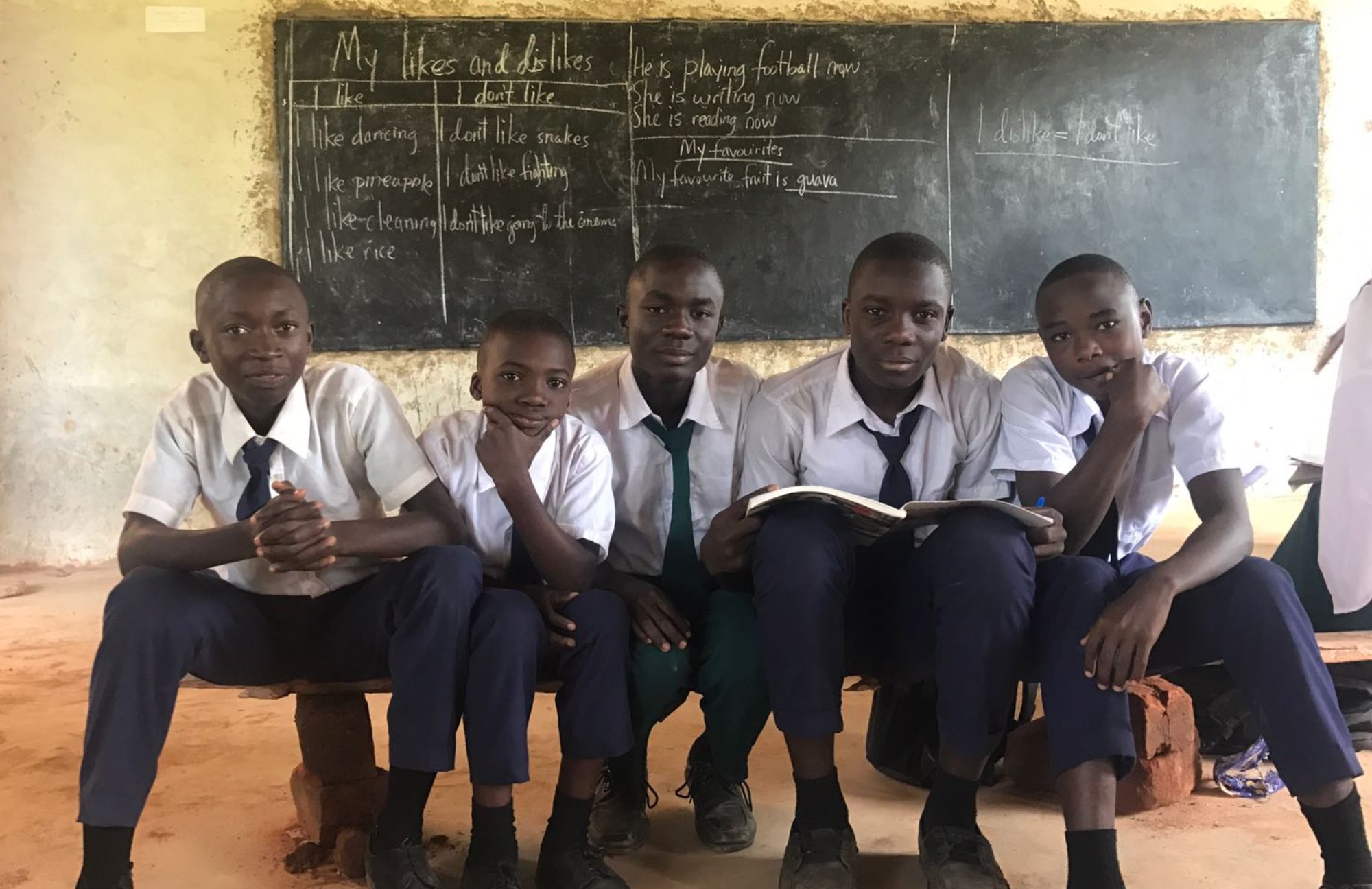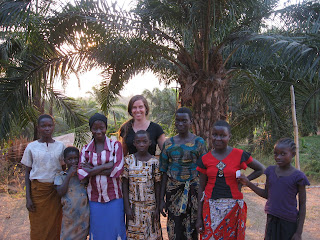Watoto is Swahili for children. Kiganza, a small village in the Kigoma region (not too far from Kigoma town) has no shortage of Watoto! The children are amazing and so beautiful, as I’ve said before. They are so independent and resilient. It is not uncommon at all to see a 10 year old carrying a load larger than herself on her head, walking the distance from Mwandiga to Kiganza (two villages connected by an hour on foot along a dusty dirt road). It’s also not uncommon to find young girls (as young as 4 years of age) toting their kid sisters or brothers on their backs, slung in a kanga with a big knot tied at their chest, the toddler on their back almost half the size of the sibling that’s carrying him/her – usually fast asleep – and all the while, the older sibling goes about with her actions: carrying a load, singing with the other children, walking to and from the market, or just sitting around, staring at the Mzungu (guess who that would be!).
(Kids at a local primary school – ready to perform for the mzungus and Yared)
After Tamrika and the gang left Kiganza, I had to find ways to fill my days. As I mentioned before, I came here to work with GOSESO, to offer workshops for local teachers, collaborate on English language curriculum, suss out my potential role here in this program … but, lacking formalized direction and, oh yeah … an existing school, I’ve been forced to forge my own way in Kiganza. One of my little adventures has involved attending a local secondary school in the village of Bitale (45 minutes on foot from Kiganza). There I attended English and Kiswahili classes with my friend, Kamilius, a young secondary student. As I sat in class, among the students, many thoughts ran through my head – thoughts of possible projects to undertake whether as separate entities or in conjunction with GOSESO – projects such as a girls’ school (the number of boys to girls is way out of proportion, creating an environment that doesn’t support the young girls – they sit quietly and uncomfortably in a sea of boys – at an age when just being an adolescent is hard, let alone being a young girl becoming a woman in a patriarchal society and having to be an uber-minority in the classroom when you know, that any year could be your last because your family will find that educating the young men might be more lucrative to the family…); projects such as teacher education to promote interactive, collaborative, communicative approaches to language and content learning and teaching – more similar to current approaches in areas where resources are not as limited … but figuring ways in which these same approaches can work in the absence of pictures, realia, overhead projectors, powerpoints, and at times – paper and pencils; projects such as implementing Project “New Eyes” in Kiganza (a program from the University of Utah that I was involved with in the Czech Republic last year) to bring university students to the small village to engage in mutual learning and understanding of cultures and educational practices … The ideas are endless and the feeling that a return to Kiganza for my dissertation is impossible is residing a bit…. you just never know and every day, I am more and more connected to this village, these children, this country – and the seeming ease with which I could have an impact on so many lives, with minimal support from home, is compelling.
Another way in which I am greatly involved with the children is through my daily “lessons” with the kids on-site at GOSESO. They know to come each evening at 6pm and I will be there to chat, teach, dance, sing, color and play games. It all started with one offer to a small group of 10 kids to come one evening and they could use the crayons and pens that Heather left behind. Heather and I had also bought each of them a daftali or notebook for writing … Well, in a village the size of Kiganza where children outnumber adults by at least 4:1, the word of the mzungu giving out free daftali spread like the fires that scorch the hillside on a weekly basis around the village (good ole slash and burn). So, my group grew from 10 to 20 overnight… I made another run to the market. The next day, 30 kids came and I had to take names … Meanwhile, Clemensia, one of my older gals tried to pass out pens and crayons and was chased like a football through the kasava fields, screaming with a great look of fear in her eyes as 15 small children tried to take her down for the pens she was carrying … It got out of control, so my buddy Lucas came and released the Cracken (Rothman, 2001) on the kids – got them to sit still and listen while he delegated some instructions. The kids, now pushing 50 in number were broken into two groups – young and older. They would meet on alternating days.
I gave up on trying to supply daftali to everyone, because every day I came, another group showed up that I hadn’t seen before and someone was always disappointed. We turned to other non-writing activities. I taught the children to play baseball, using a ball that the kids made with plastic bags and twine and a big stick from the palm tree as a bat. The bases were shirts and flip-flops. I abandoned all efforts at going into too much detail about foul balls and strikes, so this was our rudimentary version: Two teams of equal number; batter hits and runs (only one base per hit); you can get someone out by throwing the soft ball at them or tagging them with the ball in your hand (I learned the word ‘rusha’ for throw and they learned that they could toss to a baseman); once a runner was tagged, the teams switched places (from field to bat and vice versa); no points were discussed until the game had been underway without a hitch for several turnovers… and then we were all too tired anyway!
On another occasion, I discovered that only 3 girls could dance and all the other young ladies claimed they couldn’t. So, with the help of my rock star dancers, Nema, Rozi and Esta, we held dance class. The girls would show us the steps and we would all take turns in small groups performing for each other. Shortly, the boys joined us and had a hayday with showing us their routines. For both, boys and girls, the basic format was similar to a line dance only it moved forward … in other words, they start about 20 feet away and do steps that slowly progress toward the group… in the mix of their repertoire, I swear I identified the ‘lawn mower’ move and ‘the sprinkler’ and was thrilled to see something I could pull off without looking too much like a white girl! haha. The boys’ moves seemed to resemble military marches and even included a salute for one go around. Of course, as with word of the daftali, word of the dance spread within the hour and in a little Gazebo behind the GOSESO house, I was suddenly in the presence of about 40 kids – dancing had to cease for the sake of space and we turned to singing. The children are amazing – they know so many great songs (from school and culture) and they would confidently belt them out in a ‘hollah back’ fashion – one would lead with a line or two and the others would respond with the same line or a fitting response, all clapping, smiling and occasionally subbing my name or ‘mzungu’ into the song. My name, by the way, when it’s not Mzungu, is Rehema – Arabic, meaning peace, and commonly known to all – an easier name for them than Rai or Raichle and the name of a child I know and adore back in SLC (from Burundi). It’s also a name I hold dear in Kiganza as now, when I walk in the village, I hear it sung in many sweet tones by the children who come to be with me in the evenings at GOSESO – so many of them and only one of me! If only I could know all their names – but I’m doing pretty well to remember those of the more outgoing ones or the ones whose faces just pop out and whose eyes don’t let me off the hook without a flutter in my heart.





